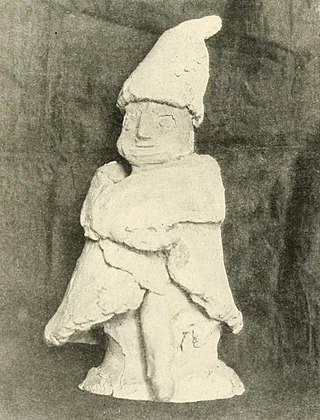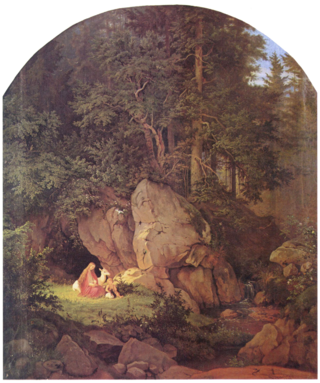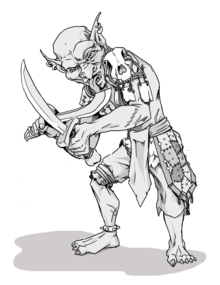A boggart is a supernatural being from English folklore. The dialectologist Elizabeth Wright described it as 'a generic name for an apparition'; folklorist Simon Young defines it as 'any ambivalent or evil solitary supernatural spirit'. Halifax folklorist Kai Roberts states that boggart ‘might have been used to refer to anything from a hilltop hobgoblin to a household faerie, from a headless apparition to a proto-typical poltergeist’. As these wide definitions suggest boggarts are to be found both within and out of doors, as a household spirit or a malevolent genius loci inhabiting fields or other topographical features.

Brian Froud is an English fantasy illustrator and conceptual designer. He is most widely known for his 1978 book Faeries with Alan Lee, and as the conceptual designer of the Jim Henson films The Dark Crystal (1982) and Labyrinth (1986). According to Wired, Froud is "one of the most pre-emiminent visualizers of the world of faerie and folktale".

A kobold is a mythical sprite. Having spread into Europe with various spellings including "goblin" and "hobgoblin", and later taking root and stemming from Germanic mythology, the concept survived into modern times in German folklore.
A hobgoblin is a household spirit, appearing in English folklore, once considered helpful, but which since the spread of Christianity has often been considered mischievous. Shakespeare identifies the character of Puck in his A Midsummer Night's Dream as a hobgoblin.

A bugbear is a legendary creature or type of hobgoblin comparable to the boogeyman, and other creatures of folklore, all of which were historically used in some cultures to frighten disobedient children.
Fairies, particularly those of Irish, English, Scottish and Welsh folklore, have been classified in a variety of ways. Classifications – which most often come from scholarly analysis, and may not always accurately reflect local traditions – typically focus on behavior or physical characteristics.

Little people have been part of the folklore of many cultures in human history, including Ireland, Greece, the Philippines, the Hawaiian Islands, New Zealand, Flores Island, Indonesia, and Native Americans.

A household deity is a deity or spirit that protects the home, looking after the entire household or certain key members. It has been a common belief in paganism as well as in folklore across many parts of the world.
A coblyn is a mythical gnome-like creature that is said to haunt the mines and quarries of Wales and areas of Welsh settlement in America.

Dokkaebi (Korean: 도깨비) are legendary creatures from Korean mythology and folklore. Dokkaebi, also known as "Korean goblins", are nature deities or spirits possessing extraordinary powers and abilities that are used to interact with humans, at times playing tricks on them and at times helping them. Legends describe different dokkaebi in many forms and beings with a thousand faces, and dokkaebi often wear hanbok.
The Denham Tracts constitute a publication of a series of pamphlets and jottings on folklore, fifty-four in all, collected between 1846 and 1859 by Michael Aislabie Denham, a Yorkshire tradesman. Most of the original tracts were published with fifty copies. The tracts were later re-edited by James Hardy for the Folklore Society and imprinted in two volumes in 1892 and 1895. It is possible that J.R.R. Tolkien took the word hobbit from the list of fairies in the Denham Tracts.

A lutin is a type of hobgoblin in French folklore and fairy tales. Female lutins are called lutines.

In the Dungeons & Dragons role-playing game, orcs are a primitive race of savage, bestial, barbaric humanoid.

In the Dungeons & Dragons fantasy role-playing game, goblins are a common and fairly weak race of evil humanoid monsters. Goblins are non-human monsters that low-level player characters often face in combat.
In Swiss folklore, Jack o' the bowl is a helpful house spirit and variously described as a brownie or kobold.

In folklore and fantasy, an enchanted forest is a forest under, or containing, enchantments. Such forests are described in the oldest folklore from regions where forests are common, and occur throughout the centuries to modern works of fantasy. They represent places unknown to the characters, and situations of liminality and transformation. The forest can feature as a place of threatening danger, or one of refuge, or a chance at adventure.
Mythic humanoids are legendary, folkloric, or mythological creatures that are part human, or that resemble humans through appearance or character. Each culture has different mythical creatures that come from many different origins, and many of these creatures are humanoids. They are often able to talk and in many stories they guide the hero on their journey.
The kobalos was a sprite from Greek mythology, a mischievous creature fond of tricking and frightening mortals. The kobaloi were companions of Dionysus and could shapeshift as Dionysus in the guise of Choroimanes-Aiolomorphos. According to one myth, they robbed Herakles while he slept. He captured them in revenge but took pity on them when he found them amusing. In one version of the myth, Herakles gave them to the Lydian queen Omphale as a gift. The kobaloi were thought to live in Euboea or near Thermopylae. Parents used tales of the kobaloi to frighten children into behaving.
The trasgo, trasno or trasgu is a mythological creature present in the tradition of several cultures of what is now northern Spain, especially in Galician, Asturian and Cantabrian traditional culture, it is also found in legends of North Portugal. There are similar creatures in the mythologies of other European cultures, such as the "gnome", "sylph", and the "kobold". The origin of this mythological creature is Celtic.












